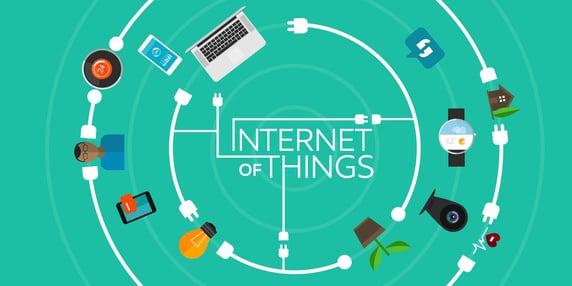How to Handle 6 Major IoT Security Issues?
IoT (Internet of Things) is the latest trend in technology. It is gearing up fast to connect any hardware devices to your smart devices. Now, you can...
3 min read
Sales : Feb 8, 2018 12:00:00 AM


Internet of things is a very powerful technology. The ability to make everything smart from a vegetable peeler to an entire city has brought out a wide range of possibilities. But even the Moon has a dark side. These smart devices are exposed to a wide number of vulnerabilities which has resulted in data and privacy risks. A report from Entrepreneur implies that today, 70% of IoT devices on the market are vulnerable out of the box.
Currently, many manufacturers are not focusing enough on handling security issues and concentrating solely on “making things intelligent”. This mindset will result in distrust among the users ultimately impacting the scale of adoption and usability of the tech. Here we will explore some of the pressing security issues in IoT and how industries are trying to deal with them.
Interested in latest technologies? Grab the latest eBooks:

IoT connects billions of devices in an interlinked ecosystem. Each sensor works as a data point that generates some information and sends it back to the main server. Since all these devices are closely connected a single vulnerability allows hackers to manipulate the entire data, making it useless or misleading.
This was seen practically possible in a research where the smart meters used in Spain could be hacked to under-report energy usage. This could be done for an entire country causing loss of millions of dollars. The similar scenario can be replicated to a business.
Read More: Use cases of IoT in Supply Chain and Logistics
The internet of things involves the use of millions of data points each of which needs to be secured. As discussed above, a single vulnerability in any one of the devices can result in a massive compromise of security.
It is also an acceptable circumstance where a contingency (virus) is spread across the network resulting in a long disease impacting the data and security of the connected devices. Developers need to strategize the methodology of handling such circumstances, which is hard to do in a complex mesh of heterogeneous devices.
Read More: 12 IoT Trends to Watch for the next 2-3 years
The sensors in an IoT network lack sophisticated process capabilities required to encrypt and decrypt data in a continuous process. Hence they fail to transmit data securely in real-time using the direct encryption process.
As a result, these devices are vulnerable to side-channel attacks. For instance, a power analysis attack can be used to reverse engineer algorithm and exploit loopholes. IoT systems should use multiple layers of defense to compensate for these limitations. For example, devices can be segregated into separate networks and firewalls should be used to prevent brute force attempts.
Read More: 13 Statistics Defining the Future of IoT
It is understood by both businesses and consumers that smart devices are meant to gather data. This data can be used to improve decision making, provide better service, improve experience etc. But the point is that there need to be some limitations to which a device can track user activities.
Little to no emphasis is made on anonymizing the data and this makes it a highly risky asset in the hands of hackers. Our homes, industries and even government are exposed to this threat. Hence it is important for manufacturers to think beyond installing WiFi chipsets and sensors and make “smart” things “secure”, even if that comes at a high cost.
Read More: 4 Best Uses of IoT in Banking and Finance
Today we are yet to have a standardized framework which can be used to address the needs of different industries. Hence all the manufacturers are completely on their own to manage the security and privacy issues.
With a more standardized framework, these individual efforts can collectively aim to help in a more scalable manner and we can enjoy reusability of code. In future industry leaders are expected to bring out some solution but till then the IoT devices are going to face tremendous complexities in this regard.
Read More: How will IoT impact the Retail of Today
Securing the devices in an IoT network is not the only concern. We also need to secure the channel of data communication and the user touchpoints like mobile app, web app and cloud storage.
Just like through devices the network can be corrupted by exploiting these user touchpoints. Hence, developers need to cater to individual security networks for each of these touchpoints which makes the development process extremely difficult and time taking.
Read More: The Uses, Benefits and Applications of IoT in Manufacturing
Any update to improve the functionality or security of IoT devices needs to be passed individually to a network of millions of devices. What’s worse is that some of the devices don’t support over the air update making it mandatory to physically access and install updates even when it is simple security patch.
You’ll need to track which updates are available and apply them to a network of heterogeneous devices that communicate using varied network protocols. This makes the process extremely complicated, time-consuming and even makes it susceptible to mistakes leading to loopholes in security.
IoT security is a complex matter of discussion and we tried to make the topic business friendly and understandable. Dealing with such complex solutions needs an innovative approach to problem-solving. Many industry leaders are seeing blockchain as a potential solution while some are in favor of creating a unified framework for both industrial and consumer IoT.
We at NewGenApps have deep expertise in working on new age technologies like IoT, Blockchain, AI, ML, etc. In case you are looking for developers to handle a project in any of these domain then feel free to contact us:

IoT (Internet of Things) is the latest trend in technology. It is gearing up fast to connect any hardware devices to your smart devices. Now, you can...

Security breaches are very common to hear when it comes to technology. Recent news updates like the one for Code Spaces security breach clearly...
1. The hour-long outage occurred when the Web security service detected a DDoS attack against one of its customers and tried to defend against it....